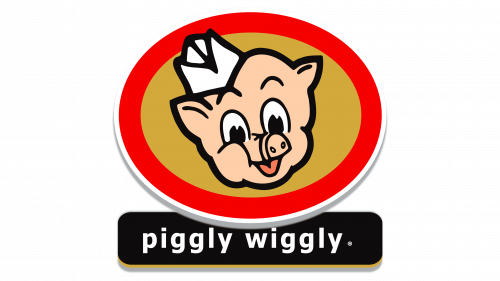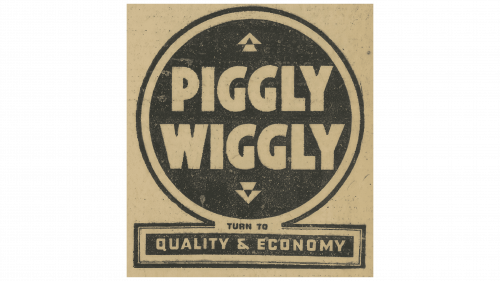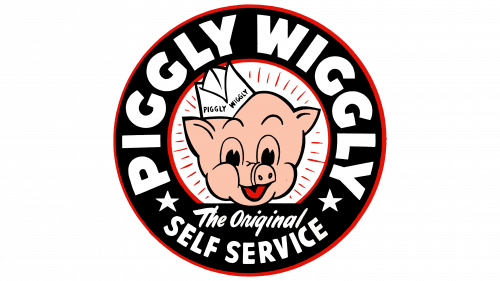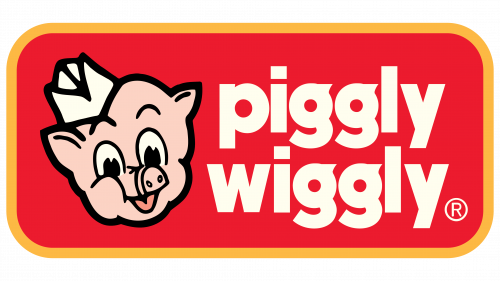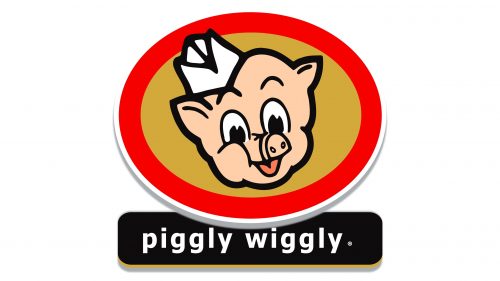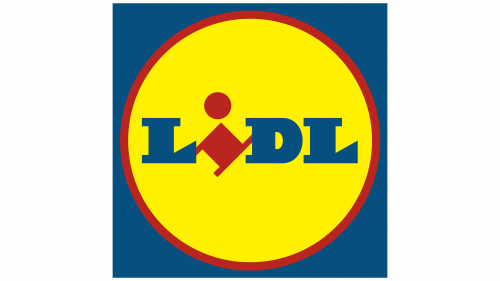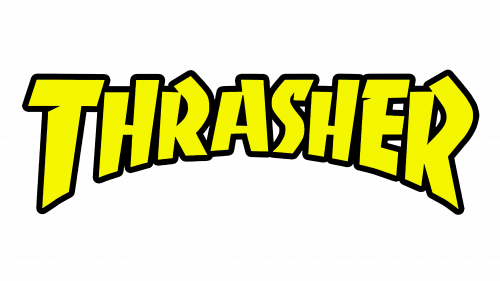The Piggly Wiggly logo evokes associations with a neat, cute pig, which serves as the mascot of the store chain. The emblem highlights the abundance and variety of food, creating a light and fun atmosphere perfect for family shopping. This friendly pig image symbolizes care for customers and their needs, giving visitors a sense of comfort and enjoyment in the shopping process.
The mascot’s face clearly expresses understanding and support for those who love delicious food and appreciate quality products. This image plays an important role in creating a positive mood, helping to associate every shopping trip with the joy and warmth of family meals. The logo builds an emotional connection with customers, making the shopping experience more pleasant and memorable.
Piggly Wiggly: Brand Overview
The story of this grocery chain began in 1916 when Clarence Saunders opened the world’s first self-service store in Memphis, Tennessee. Before this, customers would hand their shopping lists to a clerk to gather the items for them. Saunders revolutionized the shopping experience by allowing customers to pick their items from the shelves.
The name was inspired by Saunders’ observation of some pigs trying to wiggle under a fence. While the name seemed odd, it quickly gained popularity and became widely recognized.
The first store introduced several innovative features that were groundbreaking at the time but are now standard in grocery shopping. These included shopping carts, price tags on every item, organized aisles, and checkout registers, making the process more efficient and customer-friendly.
Due to the success of the original store, Saunders began franchising quickly. By 1922, the chain had grown to 1,200 stores across 29 states. That same year, the company went public and was listed on the New York Stock Exchange.
However, in 1923, the business faced severe financial challenges. A group of investors attempted to take over the company by short-selling its stock. Saunders tried to regain control by buying back a large portion of the shares, but this strategy led to bankruptcy, causing him to lose control of the company.
Despite these setbacks, the self-service model gained widespread adoption. By 1932, the grocery chain had more than 2,660 stores nationwide.
The 1940s and 1950s saw further growth and innovation. The company was one of the first to introduce refrigerated display cases to keep food fresh and began offering its private-label products, helping lower customer prices.
During the 1960s and 1970s, the grocery industry experienced a wave of consolidation, with larger companies acquiring many franchisees. The brand remained strong, thanks to its loyal customer base.
In the 1980s, the company faced increased competition from national grocery chains. In response, it focused on serving smaller, rural communities where larger chains had less presence.
1989, Shoppers Value Foods acquired the company, leading to further restructuring. The new owners focused on strengthening the brand and increasing its market share, particularly in the Southeastern U.S.
In the 2000s, the company encountered new challenges, including growing competition from discount and online retailers. The response was to update product offerings and remodel stores to meet changing consumer demands.
In 2003, C&S Wholesale Grocers acquired the largest store operator in the Carolina region, further solidifying the brand’s presence in the Southeastern U.S.
In 2014, one of the company’s major divisions was sold to Fresh Brands Inc., contributing to further decentralization.
As of 2020, the business continued to operate as a franchise network with independently owned stores. The company remained active primarily in the southern and midwestern U.S. In 2021 and 2022, it expanded online ordering and delivery services to meet modern consumer demands and compete with larger chains and e-commerce platforms.
By early 2023, despite changes in ownership and evolving market conditions, the grocery chain remained a familiar and enduring name in American retail. The franchising model allowed independent owners to tailor stores to local needs while maintaining the brand identity.
The story of this innovative grocery chain is one of adaptability and resilience. For over a century, the company has held a unique place in American retail, from pioneering the self-service concept to evolving into a network of independently owned stores.
Meaning and History
What is Piggly Wiggly?
This is an American grocery chain with an unusual name, which has become a recognizable landmark in communities across the Midwest and the South. Regular customers affectionately call this store “The Pig” because it was the first to introduce the self-service concept, radically changing how people shop for groceries. The stores are known for their cozy atmosphere and focus on local goods, often offering regional delicacies alongside well-known brands. The chain’s mascot, Mister Pig, adds a special charm to the shopping experience. The chain has successfully withstood competition from major retailers. Thanks to its franchise model, store owners can customize their product offerings to suit local community preferences, which helps maintain the store’s popularity and significance in the lives of these towns.
1916 – 1949
The first store emblem was designed as a black circle, resembling a road sign. This was symbolic, as supermarkets introduced a new approach to movement within the store. The name and arrows pointing in opposite directions—marking the entrance and exit—were added to the black surface to complete the image. This approach helped optimize customer flow inside the store.
Cash registers were moved closer to the exit to avoid crowding at the entrance and eliminate a sense of congestion. This solution allowed customers to move through the aisles orderly, picking up the necessary items from start to finish. The sign also emphasized the connection with traffic symbols, drawing attention to introducing new checkout lanes for smoother transactions.
A rectangle with inscriptions highlighting the key benefits of the new store format—speed and savings—was added to the bottom of the circle. Piggly Wiggly offered customers the option to choose their items, significantly speeding up service and lowering prices, as the store no longer needed additional staff to assist in the aisles.
The black and white colors of the logo were associated with chalkboards, where product prices were written in chalk, adding another element of simplicity and accessibility. How the brand name originated remains a mystery. One of the main theories is that the founder once saw piglets trying to escape by crawling under a fence and decided to name the store after this, as it aimed to bypass traditional retail rules. Saunders likely associated customers with piglets, so he refused to reveal the name’s true meaning during his lifetime to avoid offending anyone.
1949 – 1983
After the war, the stores adopted a brighter and more stylish logo. At the center of the emblem, which retained its circular shape, was a cheerful, smiling pig’s face wearing a paper cap resembling a grocer’s uniform. This detail emphasized the connection to the grocery business and evoked a sense of friendly service.
The pig’s radiance symbolized cleanliness and profit—key Piggly Wiggly store image elements. These stores paid Great attention to cleanliness, and the self-service system contributed to customer savings, making shopping more enjoyable and affordable.
The logo was encircled by a thick black border with the brand name written around it, highlighting its uniqueness. At the bottom of the visual sign was the phrase “the original self-service store,” underscoring the importance of Piggly Wiggly as a pioneer in this retail system. Founder Clarence Saunders’ idea to implement self-service quickly gained popularity and was adopted by other chains. To maintain its status as the originator, the logo specifically emphasized the brand’s uniqueness. Saunders also granted franchises the use of his system, yet the original store remained a popular destination for shoppers eager to visit, a source of innovations like shopping carts.
1983 – today
After Malone & Hyde acquired the brand, the logo was modified to emphasize the network’s new values and focus. A red price tag was chosen as the background, evoking associations with discounts, savings, and good deals, enhancing the store’s appeal to customers looking for bargains.
The pig’s face is on the left side of this background— the brand’s symbol, which remains unchanged, reinforcing continuity and recognition. On the right, the brand name is displayed in two levels in white font, making it easy to read and remember. The use of white combined with the red background symbolizes renewal and the guarantee of fresh products, which is important for customers seeking quality and nutritious items.
The orange border around the logo adds warmth and friendliness, emphasizing the chain’s focus on customer comfort and convenience. This color also reflects the brand’s commitment to creating a pleasant atmosphere, making the shopping experience affordable and enjoyable for visitors, and strengthening their emotional connection to the store.
2009 – today
The new owners, C & S Wholesale Grocers, combined the original mascot with the first logo, restoring the Piggly Wiggly logo to its historical roots. The emblem is designed as a circular road sign, symbolizing movement within the stores and the brand’s evolution over the decades.
The central element of the visual sign remains the recognizable Piggly Wiggly mascot. With its kind smile, this character instantly evokes associations with friendliness and accessibility, which aligns perfectly with the brand’s focus in the retail sector. The pig wears a chef’s hat, highlighting the connection between food and the kitchen, making the visual emblem vibrant and memorable for shoppers.
The lower part of the sign is styled as a black rectangular plaque with the white text “piggly wiggly.” This element recalls the chalkboards used in grocery stores to display prices and promotions. This retro touch adds a hint of nostalgia to the emblem and emphasizes the connection to its history.
The red circle with a gold background gives the logo a dynamic and cohesive appearance while maintaining its recognizability. The color palette also evokes feelings of warmth and comfort, which helps generate positive emotions among consumers.
This overall style reflects simplicity and clarity, making Piggly Wiggly a supermarket that remains a part of everyday life for many families, as it has been for decades.
